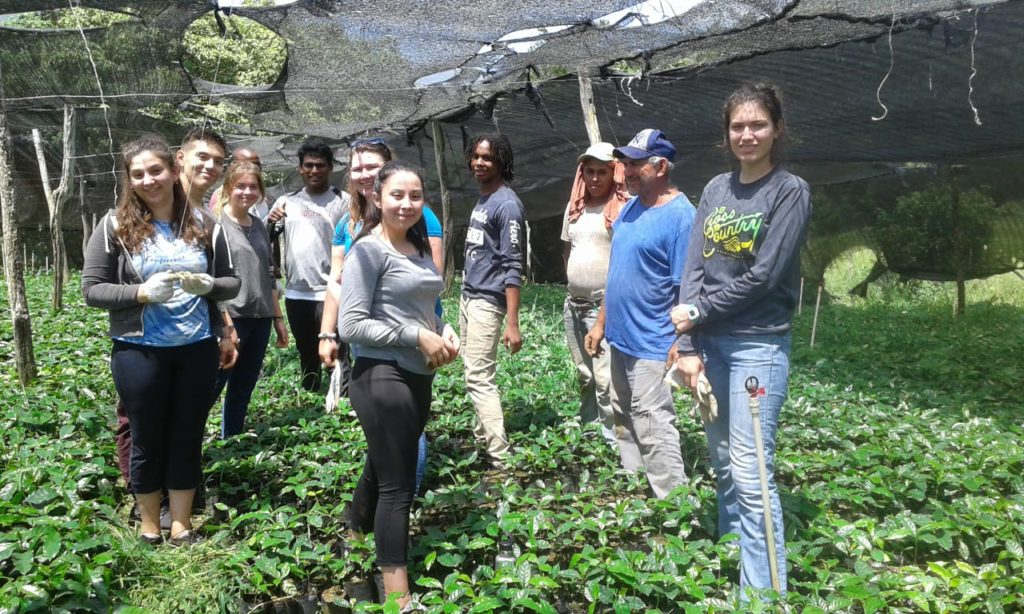Today has been our earliest day of our trip yet with starting by waking up at 5:30am and heading out to Inverdadero Los Ramirez. Our destination consisted of a beautiful coffee plantation where a few locals worked at for the U.S. equivalent of 6 dollars per day (with the national minimum wage being 4 dollars a day). We split into small groups each assigned to a worker who showed us how to either weed the growing coffee plants or how to collect and dispose of the picked weeds. We soon discovered that our local guides had beautiful personalities that we weren’t expecting to experience. Each person we met was amusing and had lots of fun stories to share with our fellow Spanish-speaking students who translated for the rest of our groups. One particular worker that stood out to us was a young teenager named Edison; he was only fourteen and was choosing to spend most of his time helping on the plantation to aid his family with their income. When asked by a student about why he didn’t attend school, he responded by saying, “You have to work hard now to enjoy life later.” As a group we felt that we could personally relate to his tribulations because we were close in age and couldn’t imagine sacrificing so much of our youth to manual labor. This experience helped us realize our actual privilege of having a choice of what we spend our money and our time on. It was something that most of us would agree that we would never forget; some students have even decided to buy a basketball and have it delivered to Edison in appreciation of his sacrifices.
After what felt like a long day of work (which had actually only been two hours of labor) we headed back home for a quick lunch before leaving again for Cafe Monte Alto. Our next activity was a tour of a coffee production factory that was linked to the coffee plantation in Inverdadero Los Ramirez. During our tour, we learned about exactly how much time and effort was required to produce a simple cup of coffee. We were surprised by the number of tasks needed to prepare the beans for exportation and by the intense working conditions they were under (such as strong heat and enclosed/tight working spaces). After the tour, we headed over to their onsite coffee shop. We were given small samples of their famous Monte Alto coffee blend, which many students decided to purchase. We were surprised at how low the prices of the blends were in comparison to the exhausting tasks that the workers in the factory faced. Discussing this with the rest of the group, we later concluded that capitalism attempted to disguise the otherwise blatant form of mistreatment of the workforce in developing countries.
Next up on our agenda, we ventured to our first day of English tutoring at a local school in Jarabacoa. The anxiety within the bus was prevalent and everyone was sharing their concerns regarding our expectations. However, we were pleasantly surprised by how the students all had amazing personalities and by how eager they were to participate. Each student came with a desire to learn English because they knew that this language was their ticket to a better life. After the class, we regrouped and discussed how relieved we were to have had experiences beyond our original expectations. One challenge we faced during teaching was competing with the roaring thunder and heavy rain; especially since it was the first rainfall we’d experienced on our trip. Overall, we had an eventful day packed with new information that challenged our previous assumptions about the driving forces behind our economy, the Dominican Republic’s economy, and the way to succeed via language.

Working in the coffee nursery

Workers in the coffee factory

Sound like you guys are having a great time.
It was very nice to hear your voice today Safiyah. I hope you are learning and having fun too at the same time. T.
I can’t wait till you come back home and tell us your experiences and also of being the leader today. Take a lot of pictures and enjoy the trip
In this day and age there are teenagers like Edison who is ready to work hard for his family rather than spend time doing what he likes.
Safiyah, very thoughtful of you students to buy him a football.